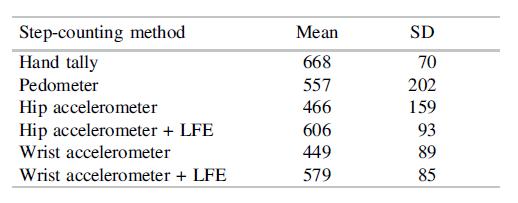The article Step-Counting Accuracy of Activity Monitors in Persons with Down Syndrome (J. Intellect. Disabil. Res. 2019:
Question:
The article “Step-Counting Accuracy of Activity Monitors in Persons with Down Syndrome” (J. Intellect. Disabil. Res. 2019: 21–30) describes a study in which 17 people with DS walked for a set time period with multiple step-counting devices attached to them. (Walking is a common form of exercise for people with DS, and clinicians want to insure that step counts for them are accurate.) The accompanying table summarizes the different step-counting methods and the number of steps recorded for each participant. (LFE refers to a low frequency extension filter applied to the device.)

Sums of squares consistent with this and other information in the article include SS(Method) = 596,748, SSE = 987,380, and SST = 2,113,228.
a. Determine the sum of squares associated with the blocking variable (subject), and then construct an ANOVA table.
b. Assuming that model assumptions are plausible, test the null hypothesis of “no method effect” at the .01 significance level.
c. Apply Tukey’s procedure to these six step counting methods. Are any of the five device-based methods not significantly different from hand tally (considered by the researchers to be the most correct)?
Step by Step Answer:

Modern Mathematical Statistics With Applications
ISBN: 9783030551551
3rd Edition
Authors: Jay L. Devore, Kenneth N. Berk, Matthew A. Carlton





